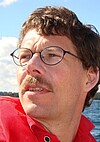PD Dr. rer. nat. Jens Christian Claussen, PD Dr. rer. nat.

Privatdozent
Institut für Neuro- und Bioinformatik
Ratzeburger Allee 160 (Geb. 64)
23562 Lübeck

Privatdozent
Institut für Neuro- und Bioinformatik
Ratzeburger Allee 160 (Geb. 64)
23562 Lübeck